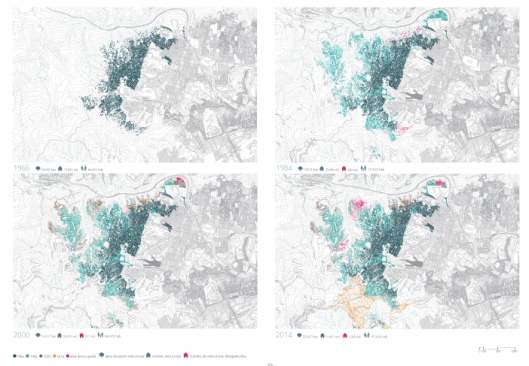I am reading and slowly re-reading Tafuri’s works; currently Architecture and Utopia and The Sphere and the Labyrinth. My sense with Tafuri is that he has been largely ignored in the American academy, in Art History and in History departments, as well as in other departments where his suggestive, highly original, and very complex work should hypothetically be of interest. There are, however, a few scholars working to reassess Tafuri’s work, perhaps foremost among them Pier Vittorio Aureli, who among other things has written about the role of Fredric Jameson in framing Tafuri’s reception in the United States. Nonetheless, it seems to me that the work of systematically traversing Tafuri’s thought has just begun. Although I am just beginning a dissertation on discourses on space in Bogotá, Colombia, in the period between 1970 and the present, Tafuri has already largely informed my approach to the problem of architectural discourses as they relate to the city and capitalist expansion. I have the feeling that out of the current work, another long-term project, this one on Tafuri, is slowly emerging.
The introduction to The Sphere and the Labyrinth includes a fascinating theoretical discussion on the approach to historical work in general, and to architecture history in particular. Here Nietzsche and Foucault are clearly registered as thinkers of influence for Tafuri, though critique is levied against basic concepts underlying Foucault’s theoretical framework. (Which leads me to ask: is cultural critique in literature, cinema, art, and in similar fields, now approached in a performative manner, in which a schema is applied almost as an experimental framework in order to “yield knowledge,” regardless of the theoretical and philosophical cohesiveness of given framework? In current academic writing in the humanities it seems less and less likely to find a rigorous theoretical discussion that takes into account the philosophical grounding of basic concepts, preceding the work of analysis).
Tafuri adopts Foucault’s notion of genealogy, as counter to a notion of historical work as method for revealing an origin. Nor does historical work simply trace a linear dynamic. Each event registered by the historical analysand is encountered in its quality as rupture, as shift, as derailing of a perceived relation of cause and effect.
Yet Tafuri questions genealogy’s differentiation of history into an unbound plurality that devolves into a new set of idealities:
“The danger that menaces the genealogies of Foucault–the genealogies of madness, of the clinic, of punishment, of sexuality–as well as the disseminations of Derrida, lies in the reconsecration of the microscopically analyzed fragments as new units autonomous and significant in themselves” (Tafuri 5).
There can be no new synthesis at the level of basic elements:
“One could try endlessly to exorcize the uneasiness provoked by the perception of “epistemological breaks” by attempting to regain the innocence of archetypal symbols; the pyramid, the sphere, the circle, the ellipse, and the labyrinth could be installed as permanent structures of inexplicably changing forms, so that the archaeologist [in Foucault’s sense of the term] could placate his anxiety by recognizing “an eternal return of the same.”” (6)
As for the relationship between practices and discourse, Tafuri describes it as such:
“The “many languages” of the forms thus lead us to discover that the limit of the forms themselves does not contain monads casually floating in their “divine” self-transformation. The boundary line… is there to mark the points of impact that determine the interaction of signifying practices with power practices endowed with their own specific techniques.” (8)
But how to navigate the unacceptable poles of idealism and of an analysis of fragmentation that at another level is also based on censure, repression, negation? In other words, how to subvert the will to knowledge inherent in all discourse, including “critical discourse”? Here is the key passage of the introduction:
“As representation, history is also the fruit of a repression, of a negation. The problem is to make of that negation a determinate abstraction, to give a sense of direction to theoretical work. Not by chance does Marx employ abstraction for the analysis of political economy” (10)
In terms of a strategy and a goal, then, to put things in very instrumental terms, the discourse of the historian is an abstraction, but one that has effects on the real and that therefore calls for another level of reflection on the part of the historian: “Every analysis is therefore provisional. Every analysis seeks only to measure the effects that it sets into motion in order to change itself according to the intervening transformations” (12).
Two problems arise, as far as I am concerned, from these reflections.
On the one hand, it seems that Tafuri reconfigures a Marxist critique of political economy into a tool of discourse analysis in the mode of a genealogy, an amalgamation that seems unstable on the very surface of things.
Related to this, there is the problem of the normative ground for this historical method. Where Marx is brought into the discussion by Tafuri it seems that the underlying reason of application has to do with the notion that the division of labor wrought by capitalism is intricately related to the differentiation of discourses and techniques. Yet here Tafuri ties this differentiation between discourse and technique directly to the workings of Power. “Is not the distance that separates words from things–the divorce of the signifier from the signified–an instrument of differentiated techniques of domination?” (12)
Note the close association implied in the divorce between signifier and signified (a tool of power) and the division of labor as a form of abstraction (wrought by capital, a field of practice and discourse criscrossed by power relations).
Is there a concrete situation that would undo both abstract labor and the division of signifier and signified and return to practical life a concrete fit between values and practices at the level of social life? Or would such a utopian end-point only classify as one of the idealities that Tafuri figures as mythical (and ultimately abstract)?
But this raises the question: Historical work, which is incessantly reconfiguring itself based on its effect in this field of forms (of discourses and practices), measures the effectiveness of its influence, decides how to proceed based on reflection on that influence and its effects… how? What is the normative stance from which it proceeds? Which is the superordinating framework here: that of Marx, or that of Foucault?
To put things most simply: are we dealing here with formations of power, where power is the key term, or with capitalism as form of the relations of production that features its own dynamics of exploitation at the level of labor. Perhaps these are not conflicting stances, and they can indeed be fitted together. Is there a legitimate form of power?
Tafuri goes on:
“This means placing emphasis on the dialectic that in time comes to establish itself between concrete labor and abstract labor, in the Marxian meaning of both terms. In this way, the history of architecture can be read on the basis of historiographical parameters that are relative to both the vicissitudes of intellectual labor and to the development of the modes and relations of production'” (14).
Marxist ideological analysis seems in the end to be the predominating framework. Yet this would mean the positing of that utopian end-point in which a crystal-clear society realigns to an extent signifier and signified, use value and labor, at the level of concrete social practices. Does not the amalgamation of Foucault and Marx campaign agains this? Put another way: does not Tafuri’s attention, framed in Foucault’s terms, to the flux of languages and practices (forms) also preclude this possibility?
The theoretical framework applied here remains in a state of tension, which I think requires further analysis.




